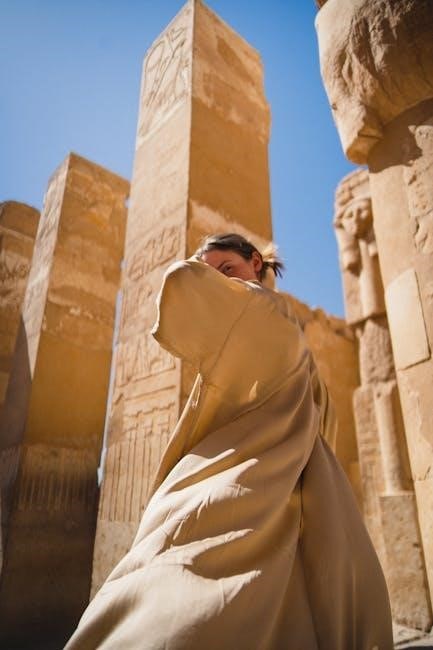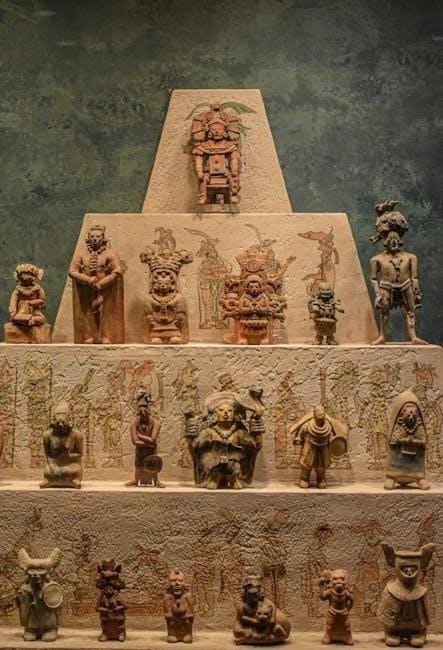Explore the rise and evolution of ancient civilizations through a detailed timeline. From Mesopotamia to Egypt, Mesoamerica, and beyond, this timeline highlights key milestones, inventions, and cultural developments that shaped human history. Discover how early societies laid the foundation for modern civilizations.
Early Civilizations
Early civilizations emerged in fertile river valleys, fostering innovation and culture. Mesopotamia, Egypt, the Indus Valley, and early China developed writing, governance, and agriculture, laying the groundwork for modern society. These pioneers shaped human history with their advancements in technology, trade, and urban planning.

Mesopotamia: The Cradle of Civilization

Mesopotamia, often called the “Cradle of Civilization,” was a region in the Fertile Crescent between the Tigris and Euphrates rivers. It was here that the Sumerians emerged around 4500 BCE, establishing some of the world’s earliest cities, such as Ur and Uruk. The invention of cuneiform, one of the earliest forms of writing, revolutionized communication and record-keeping. Mesopotamians also developed the wheel, which transformed transportation and trade, and created sophisticated irrigation systems to support agriculture.
The Sumerians are credited with advancements in governance, including the creation of city-states and early legal codes. Ziggurats, massive temple complexes, were built to honor their gods, reflecting their religious and cultural sophistication. Mesopotamia’s influence extended beyond its borders, with trade networks stretching to regions like the Indus Valley and Egypt. By 3100 BCE, the Sumerian civilization had laid the foundation for future empires, including the Akkadian and Babylonian dynasties, which further advanced science, law, and architecture.
Despite its eventual decline, Mesopotamia’s legacy endured, shaping the development of subsequent civilizations and leaving a lasting impact on human history. Its innovations in writing, governance, and technology remain cornerstones of modern society, cementing its place as the cradle of civilization.
Ancient Egypt: The Nile Valley Civilization
Ancient Egypt emerged as one of the earliest and most influential civilizations, flourishing along the Nile River from circa 3100 BCE to 1070 BCE. The unification of Upper and Lower Egypt by King Narmer (c. 3100 BCE) marked the beginning of the Early Dynastic Period, setting the stage for a golden age of cultural, architectural, and scientific advancements.
The Old Kingdom (c. 2613–2181 BCE) is renowned for the construction of the Pyramids of Giza and the Great Sphinx, showcasing Egypt’s engineering prowess and religious devotion. The development of hieroglyphics, a sophisticated writing system, allowed for the recording of laws, myths, and historical events. Egyptian society was deeply rooted in religion, with a pantheon of gods and the belief in an afterlife, which led to practices like mummification and elaborate tomb constructions.
The New Kingdom (c. 1570–1070 BCE) saw Egypt’s territorial expansion under powerful pharaohs such as Ramses II and Hatshepsut, who strengthened trade and military might. Advances in medicine, astronomy, and mathematics further solidified Egypt’s legacy. The Nile’s annual flooding made agriculture thrive, forming the economic backbone of the civilization.
Ancient Egypt’s decline began with internal strife and external invasions, but its cultural and architectural achievements left a lasting impact on subsequent civilizations, making it one of history’s most enduring legacies.
Indus Valley Civilization: Urbanization and Trade
The Indus Valley Civilization, flourishing around 2600–1900 BCE, was one of the earliest urban cultures, located in the Indus Valley region of modern-day Pakistan and northwest India. Renowned for its advanced urban planning, it featured cities like Harappa and Mohenjo-Daro, characterized by grid layouts, sophisticated drainage systems, and standardized construction materials.
Trade was a cornerstone of this civilization, with evidence of commerce with Mesopotamia and other regional societies. Artifacts such as seals, pottery, and beads suggest a vibrant exchange network. The civilization likely traded goods like cotton, metals, and semi-precious stones, highlighting their economic and cultural connections.
Culturally, the Indus Valley people are noted for their unique writing system, which remains undeciphered, and their expertise in craftsmanship. Their urbanization and trade practices set a benchmark for early civilizations, showcasing a blend of innovation and organizational prowess that would influence future societies.
Early China: The Shang and Zhou Dynasties
The Shang Dynasty (c. 1600–1046 BCE) marked the beginning of historically verified Chinese civilization. It was characterized by the development of a writing system, as evidenced by oracle bones, and advancements in bronze technology. The capital, Anyang, was a center of political and religious power, with kings ruling over a network of city-states.

The Zhou Dynasty (1046–256 BCE) succeeded the Shang, overthrowing the last Shang king. The Zhou introduced the concept of the “Mandate of Heaven,” legitimizing their rule through divine authority. This period saw the expansion of Chinese territory and the establishment of a feudal system, where regional lords governed under the Zhou king.
Culturally, the Zhou Dynasty is known for the development of Confucianism and the refinement of rituals and morality. The later Zhou period, particularly the Spring and Autumn (771–476 BCE) and Warring States (475–221 BCE) eras, witnessed significant philosophical and military advancements, setting the stage for the unification of China under the Qin Dynasty.
The legacy of the Shang and Zhou Dynasties lies in their contributions to Chinese writing, political philosophy, and societal structure, laying the foundation for the rise of imperial China.

Regional Civilizations
Regional civilizations flourished in Mesoamerica, Africa, and Europe, showcasing diverse cultural and technological advancements. The Olmec, Maya, and Aztec in Mesoamerica, Nubia and Kush in Africa, and the Minoans, Mycenaeans, and early Greeks in Europe each developed unique societies, leaving lasting legacies.
These civilizations thrived between 1500 BCE and 500 CE, contributing to trade, architecture, and governance, while shaping the cultural landscape of their regions and beyond.
Mesoamerica: The Olmec, Maya, and Aztec
Mesoamerica, encompassing modern-day Mexico and Central America, was home to three of the most influential ancient civilizations: the Olmec, Maya, and Aztec. The Olmec civilization, often regarded as the “mother culture” of Mesoamerica, emerged around 1500 BCE and is renowned for its colossal stone heads and early writing systems. They laid the foundation for subsequent civilizations with their advanced knowledge of astronomy and mathematics.
The Maya civilization flourished from 2000 BCE to 1500 CE, excelling in architecture, astronomy, and trade. Their sophisticated cities, like Tikal and Palenque, featured pyramids and temples, while their calendar system remains a testament to their intellectual prowess. The Maya’s complex hieroglyphic writing system and understanding of zero in mathematics were groundbreaking.
The Aztec empire, rising to power in the 14th century and ending with the Spanish conquest in 1521, was a dominant force in Mesoamerica. Centered in Tenochtitlán (modern-day Mexico City), the Aztecs built a vast and efficient empire, known for its intricate engineering, including floating gardens and a sophisticated drainage system. Their religious practices, calendar systems, and art left a lasting legacy in the region.
These civilizations not only shaped Mesoamerica but also influenced broader cultural and technological developments, leaving behind a rich heritage that continues to fascinate and inspire today.
Ancient Africa: Nubia and the Kingdom of Kush
Ancient Africa was home to powerful and sophisticated civilizations, with Nubia and the Kingdom of Kush standing out as prominent examples. Located along the Nile River in what is now Sudan and southern Egypt, Nubia emerged as a distinct civilization around 2000 BCE. Known for its rich cultural heritage and strategic position, Nubia became a hub for trade and cultural exchange.
The Kingdom of Kush, which flourished from approximately 700 BCE to 300 CE, was a major power in the region. Its capital, Meroe, was renowned for its impressive pyramids and vibrant culture. The Kushites were skilled architects, leaving behind a legacy of well-preserved monuments that reflect their unique blend of African, Egyptian, and Mediterranean influences.
Nubia and Kush were deeply connected to Egypt, with periods of both conflict and cooperation. The Kushites even conquered Egypt in the 8th century BCE, establishing the 25th Dynasty. Their rule showcased the cultural and military prowess of Nubian leadership.
Religion played a central role in Nubian society, with deities like Amun and Isis being worshipped alongside local gods. The region’s strategic location facilitated trade in gold, ivory, and ebony, enriching its economy and culture.
The decline of the Kingdom of Kush by the 4th century CE was due to internal instability and external pressures, including the rise of the Axum Empire in Ethiopia. Despite this, Nubia’s legacy endures as a testament to Africa’s ancient civilizations and their enduring impact on history.
Europe: The Minoans, Mycenaeans, and Early Greeks
The civilizations of Minoans, Mycenaeans, and early Greeks laid the foundation for European history. Emerging around 2600 BCE, the Minoans on Crete were known for their advanced palaces, such as Knossos, and their vibrant art depicting bull-leaping rituals. Their trade networks stretched across the Mediterranean, influencing neighboring regions.
The Mycenaeans, flourishing from 1600 to 1100 BCE, established city-states like Mycenae and Tiryns. Renowned for their Cyclopean walls, they were a warrior society that likely inspired the epic tales of the Trojan War. Their decline around 1100 BCE marked the start of the Greek Dark Ages, a period of relative obscurity.
By 800 BCE, early Greeks began to emerge, forming city-states like Athens and Sparta. This era saw the rise of the Greek alphabet, adapted from Phoenicians, and the roots of democracy. The cultural and philosophical advancements of this period would later define Classical Greece, shaping Western civilization’s intellectual heritage.
These early European civilizations, though distinct, shared a common legacy of innovation and cultural richness, paving the way for the rise of Classical Greece and beyond. Their contributions remain central to understanding the development of Western history.

